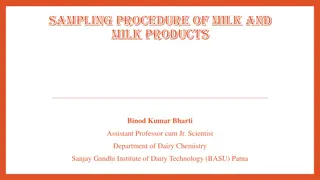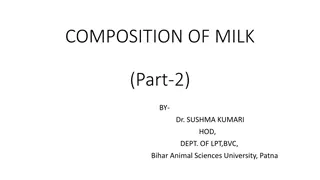Understanding the Importance of Milk, Yoghurt, and Cheese in Your Diet
Exploring the significance of milk, yoghurt, and cheese in providing essential nutrients like calcium, protein, and vitamins for bone health and overall well-being. Learn about different types of milk products, their nutritive value, and the role they play in a healthy diet. Discover sources of milk, cooking effects, processing methods, and guidelines for buying and storing dairy products.
Download Presentation

Please find below an Image/Link to download the presentation.
The content on the website is provided AS IS for your information and personal use only. It may not be sold, licensed, or shared on other websites without obtaining consent from the author. Download presentation by click this link. If you encounter any issues during the download, it is possible that the publisher has removed the file from their server.
E N D
Presentation Transcript
Milk Chapter 14: Milk, Yoghurt and Cheese Group
What I Will Learn To identify sources of milk To identify the nutritive value of milk and milk products To assess the importance of milk and milk products in the diet To discuss the effects of cooking and processing on milk To state how milk and milk products are used in cooking To describe how milk is processed To compile a set of guidelines for buying and storing milk and milk products To consider the role of milk alternatives
Milk, Yoghurt and Cheese Milk, yoghurt and cheese provide calcium needed for healthy bones and teeth. Calcium is important for children, teenagers and older adults. Children aged nine to eighteen years need five servings a day. Older and younger people require three servings each day. When choosing foods from this shelf on the food pyramid, choose milk and yoghurt more often than cheese as it can be high in saturated fat especially full-fat cheese.
Milk Irish people drink more milk than most other people in the world. Milk is a refreshing drink that is full of nutrients. Cows are the most common source of milk, but milk from sheep, goats, buffalo and camels are also used in some cultures. Soya, coconut and almond milk are increasing in popularity, though they are not technically milk . Infants can live on milk alone for the first six months of their lives. Milk is used to manufacture butter, cream, yoghurt and cheese.
Class Activity Guess the milk! In front of you are different samples of milk, labelled A, B, C, D and E. 1. Taste each of the milks in your cup. 2. Can you identify the type of milk in each cup: full-fat, slimline, soya, almond and goats . 3. Record some of the nutritional information listed on the milk cartons. 4. Skimmed milk is not suitable for children under five and low-fat milk is not suitable for children under two. Can you find out why? See Activity 14.1 in the TRB
Nutritive Value Milk is a good source of HBV protein (3.5%). It is needed for growth and repair of cells. Fat (4%) in milk is an easily digested saturated fat, so it is a suitable drink for children, invalids and the elderly. It also provides heat and energy. When milk is skimmed, most of the fat is removed (0.2%). The carbohydrate (4.5%) in milk is in the form of a sugar called lactose, which provides heat and energy.
Nutritive Value Calcium is the main mineral in milk, which contributes to healthy bones and teeth. It also contains phosphorus. Milk contains vitamin B for a healthy nervous system. The fat- soluble vitamin A is needed for growth, healthy eyes, skin and membranes, and vitamin D is needed for healthy bones and teeth. Milk contains a large amount of water (87%).
Dietetic Value Milk is a nourishing food because it contains many nutrients. It is important in the diets of toddlers, children and adolescents, as well as pregnant and nursing mothers. It is relatively cheap and readily available in a variety of types. It is easily digested and necessary in the diet of invalids and older people.
Dietetic Value (continued) Skimmed milk is suitable for those on a low- kilocalorie diet, but it is not suitable for children as it lacks vitamin A, D and fat. Milk is available fortified with vitamins A and D, calcium, iron, folic acids and omega-3 fatty acids, e.g. Supermilk. As milk is lacking in iron, fibre, starch and vitamin C, it is best combined with cereals and fruit to give a balanced meal.
Class Activity Think-Pair-Share: Nutrition labelling activity 1. Look at the empty milk carton in front of you. 2. For homework, present the nutritional information from the milk carton in a creative manner, e.g. compile a fact sheet, an information leaflet, a poster or a chart. See Activity 14.3 in the TRB
Uses of Milk Milk is a very versatile food with many culinary uses. Drinks: milkshakes, coffee, hot chocolate Sauces: white roux and custards Enriching dishes: soup, mashed potatoes Milk-based desserts: milk puddings, custard dishes In baking: bread, scones Batters: pancake, coating, Yorkshire pudding Glazing: baked goods
Effects of Heat on Milk Loss of vitamins C and B-group vitamins. Flavour is changed. Bacteria are destroyed. Protein coagulates and forms a skin on the surface of milk. Steam builds up under this skin and causes the milk to boil over. Class Activity Heat milk in a saucepan until it boils. You will see a skin forming on top. Why does this happen? Allow the milk to cool, taste and note the change in flavour.
Buying and Storing Milk Milk is a perishable food that is easily infected by bacteria, which can lead to food poisoning, so it must be stored safely. Check the expiry date before buying and do not mix milks of different dates, e.g. topping up a milk jug. Keep out of sunlight as vitamins will be lost and it will sour quickly. Keep milk and dairy products cool, clean and covered in a container or a clean jug. Store in a refrigerator. Keep away from strong-smelling food.
Milk Processing Milk is processed, i.e. homogenised, to improve its flavour and to make it safe to drink by destroying pathogenic bacteria, e.g. during pasteurisation and other heat treatments. This all helps to increase the shelf life of milk. Pathogenic means disease- causing bacteria.
Homogenisation Milk is homogenised to distribute the fat. This makes the milk creamier before it is heat-treated. Fat in one place Fat distributed Milk being homogenised
Heat Treatments Pasteurisation Most milk is pasteurised. Milk is heated to 72 C for 25 seconds, then cooled rapidly and packed in bottles and cartons. It does not alter the flavour, but kills harmful bacteria. Pasteurised milk lasts 3 4 days in the fridge.
Heat Treatments (continued) Ultra-high temperature (UHT) sterilisation Milk is heated to a high temperature 132 C for one to three seconds, then cooled rapidly and packed in sterile containers. There is a change in flavour, all bacteria are killed and vitamins C and B are destroyed. Sealed cartons don t need refrigeration and keep for months.
Types of Milk Whole milk Nothing added or taken away, just homogenised and pasteurised. The most popular type of milk in this country. Recommended for young children.
Types of Milk (continued) Low-fat milk Over half the fat is removed. Adults, low-cholesterol and low- kilocalorie diets. Skimmed milk Almost all fat removed. Adults, low-cholesterol and low- kilocalorie diets.
Types of Milk (continued) Fortified milks (Super) with extra vitamins and minerals added. Suitable for everyone, especially for those at risk of bone disease.
Types of Milk (continued) Long-life milk UHT. If unopened, it keeps for months. Good for camping, on planes and in warm countries. Buttermilk Acidic liquid left over after butter is made. Used for baking.
Types of Milk (continued) Flavoured milk Flavourings like vanilla, chocolate and strawberry are added. Suitable for children but can be high in sugar. Dried All moisture removed, keeps for long time in sealed container. Useful for camping, baby milk and in emergencies.
Types of Milk (continued) Evaporated Some water removed, sterilised and sealed in a can. Keeps for over a year. Used in desserts and baking. Condensed Some water removed, sugar added, sterilised and sealed in a can. Keeps well. Used for desserts and baking.
Class Activity 1 Fill in the information on the table you have been given. Type Description Uses Price and size of container Whole milk Low-fat milk Skimmed milk Fortified milk Long-life milk Buttermilk Flavoured milk
Class Activity 2 In pairs, look at the two cartons of fortified milks in front of you and find all the answers using the information on the carton and your knowledge of nutrition and diets.
Milk Substitutes People who are lactose intolerant cannot convert lactose (milk sugar) to glucose. For this reason, lactase can be added to milk to convert it before consumption. Milk is not consumed by vegans, so they need an alternative. Soya milk is used as a substitute, but it has to be fortified because it lacks calcium and some vitamins. Some people may be allergic to cow s milk and find goat's milk more suitable. Other alternatives available include almond, coconut, hazelnut, cashew and rice milk.
Milk: Quick Revision 1. Explain why milk is important in the diet. 2. Outline the effects of cooking and processing on milk. 3. Describe two ways that milk is processed. 4. Discuss the role of milk alternatives in the diet.























